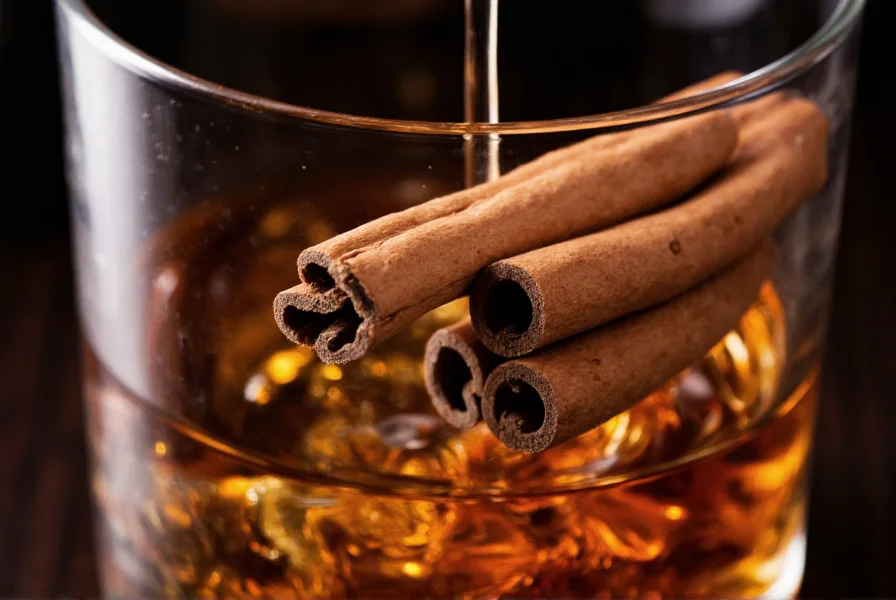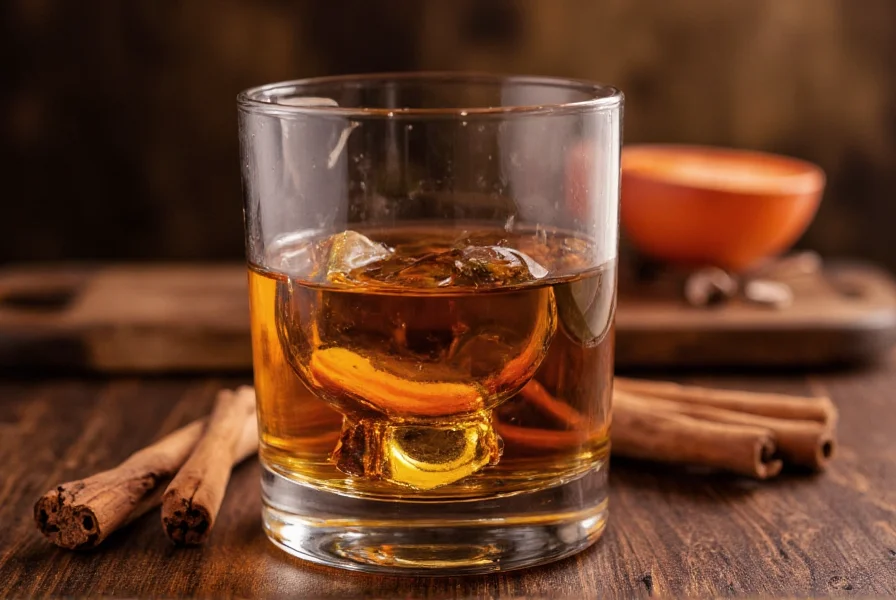Cinnamon whisky has gained significant popularity as a versatile spirit that combines the complexity of traditional whisky with the warm, aromatic qualities of cinnamon. This distinctive spirit appeals to both whisky enthusiasts seeking new flavor dimensions and those who might find unflavored whisky too intense. Understanding its production methods, flavor characteristics, and optimal uses can enhance your appreciation and enjoyment of this unique beverage.
What Exactly Is Cinnamon Whisky?
Cinnamon whisky represents a category of flavored whisky where cinnamon serves as the primary complementary flavor. Unlike traditional whisky which relies solely on grain, water, and barrel aging for its flavor profile, cinnamon whisky incorporates cinnamon through various methods:
- Natural infusion - Adding cinnamon sticks or powder to matured whisky
- Distillation integration - Introducing cinnamon during the distillation process
- Flavor blending - Combining whisky with natural cinnamon extracts
The best cinnamon whisky varieties maintain the foundational characteristics of quality whisky while allowing the cinnamon notes to enhance rather than overwhelm the spirit. Premium examples showcase a balanced integration where the cinnamon complements rather than masks the underlying whisky's complexity.

Historical Context of Spiced Whiskies
While modern cinnamon whisky has gained commercial prominence in recent decades, the practice of flavoring spirits with spices dates back centuries. Early distillers often added spices to mask imperfections in poorly distilled spirits or to create medicinal tonics. The specific combination of whisky and cinnamon became more refined as distillation techniques improved and consumer preferences evolved toward more sophisticated flavor profiles.
Traditional Scottish and Irish whisky makers historically avoided flavor additions, considering them adulterations of the pure spirit. However, North American distillers, particularly in the United States and Canada, embraced flavored whisky variations, leading to the development of commercially successful cinnamon whisky products that now occupy significant shelf space in liquor stores worldwide.
Production Methods and Quality Indicators
Understanding how cinnamon whisky is made helps identify quality products. The production process significantly impacts the final flavor profile and overall drinking experience:
| Production Method | Flavor Characteristics | Quality Indicators |
|---|---|---|
| Natural infusion | Bright, fresh cinnamon notes; gradual flavor development | Clear liquid; balanced spice; no artificial aftertaste |
| Distillation integration | Integrated spice notes; complex flavor layers | Smooth mouthfeel; harmonious flavor profile |
| Flavor blending | Pronounced cinnamon; potentially artificial notes | Check ingredient list; natural flavors preferred |
High-quality cinnamon whisky maintains the essential characteristics of good whisky—complexity, balance, and a pleasant finish—while adding complementary cinnamon notes. The best examples avoid artificial flavors and excessive sweetness that can overwhelm the spirit's natural qualities.
Flavor Profile Analysis
Cinnamon whisky offers a distinctive sensory experience that differs significantly from traditional unflavored varieties. When evaluating quality cinnamon whisky, consider these flavor dimensions:
- Aroma - Should present both whisky notes (vanilla, oak, caramel) and cinnamon spice without artificial chemical notes
- Palate - Initial whisky flavors should transition smoothly to cinnamon warmth, not a sudden spice shock
- Mouthfeel - Quality examples maintain whisky's characteristic body without becoming syrupy
- Finish - Cinnamon warmth should linger pleasantly without harsh alcohol burn or artificial aftertaste
The most balanced cinnamon whiskies showcase a progression of flavors where the whisky base remains recognizable while the cinnamon enhances rather than dominates. Premium examples often reveal additional flavor layers with careful tasting, including hints of baking spices, citrus, or dried fruit that complement the primary cinnamon notes.
Practical Applications: Cocktails and Pairings
Cinnamon whisky's versatility makes it valuable for both mixing and sipping. Understanding optimal uses enhances your experience with this spirit:
Cocktail Applications
When crafting cinnamon whisky cocktails, consider these successful combinations:
- Cinnamon Whisky Sour - Combines cinnamon whisky with lemon juice, simple syrup, and egg white for a balanced, refreshing drink
- Spiced Old Fashioned - Substitutes traditional bourbon with cinnamon whisky for a warm, complex variation
- Apple Cinnamon Mule - Blends cinnamon whisky with apple cider and ginger beer for a seasonal favorite
- Hot Cinnamon Toddy - Ideal for cold weather, mixing cinnamon whisky with hot water, honey, and lemon
Food Pairings
Cinnamon whisky complements various foods, particularly those with complementary flavor profiles:
- Desserts - Pairs exceptionally well with apple pie, bread pudding, and chocolate-based desserts
- Cheeses - Complements aged cheddar, gouda, and blue cheeses
- Breakfast items - Excellent with French toast, pancakes, and waffles
- Spiced dishes - Works with Moroccan tagines and other dishes featuring warm spices

Creating Your Own Cinnamon Whisky at Home
For those interested in crafting personalized cinnamon whisky, home infusion offers a rewarding DIY approach. This method allows complete control over flavor intensity and quality:
- Select a quality base whisky (bourbon or rye work particularly well)
- Choose fresh, high-quality cinnamon sticks (avoid powder for cleaner infusion)
- Use a ratio of 2-3 cinnamon sticks per 750ml bottle of whisky
- Store in a cool, dark place, tasting periodically after 24 hours
- Remove cinnamon when desired flavor intensity is reached (typically 3-7 days)
- Filter if necessary to remove sediment
The beauty of homemade cinnamon whisky lies in customization. You can adjust infusion time for mild or pronounced cinnamon notes, experiment with different whisky bases, or add complementary spices like vanilla beans or orange peel for complex variations. This approach to making cinnamon whisky at home ensures no artificial additives while allowing personalization to your exact taste preferences.
Serving and Storage Recommendations
Proper serving enhances the cinnamon whisky experience:
- Serving temperature - Slightly chilled (not ice-cold) preserves flavor complexity
- Glassware - Use tulip-shaped glasses or traditional whisky glasses to concentrate aromas
- With mixers - Quality cinnamon whisky often needs little enhancement; try with a splash of water or优质 ginger ale
- Neat - High-quality examples shine when served without mixers to appreciate full flavor profile
For storage, keep cinnamon whisky in its original bottle with a tight seal, away from direct sunlight and temperature fluctuations. Unlike wine, whisky doesn't continue aging in the bottle, but proper storage prevents flavor degradation. Most quality cinnamon whiskies maintain their character for several years when stored properly.
Understanding Quality Variations
Not all cinnamon whiskies deliver equal quality. When selecting products, consider these factors:
- Base whisky quality - The foundation determines overall quality; premium base whiskies yield better results
- Flavoring method - Natural infusion generally produces more balanced results than artificial flavoring
- Sweetness level - Some brands add significant sugar; check labels if you prefer less sweetness
- Alcohol content - Traditional whisky ranges (40-50% ABV) work best; avoid watered-down versions
Developing your palate for cinnamon whisky involves sampling different brands and styles to identify your personal preferences. Take notes on flavor profiles, mouthfeel, and finish to build your understanding of what constitutes quality in this category.
Conclusion
Cinnamon whisky represents a thoughtful fusion of traditional distilling and creative flavor exploration. When crafted with care, it offers a distinctive drinking experience that appeals to both whisky traditionalists and those new to the spirit. By understanding production methods, flavor characteristics, and optimal uses, enthusiasts can fully appreciate this versatile spirit. Whether enjoyed neat, in classic cocktails, or as a culinary companion, quality cinnamon whisky provides a warm, complex experience that continues to evolve in sophistication as the category matures.
Frequently Asked Questions
What's the difference between cinnamon whisky and regular whisky?
Cinnamon whisky is a flavored variation that incorporates cinnamon notes through natural infusion, distillation integration, or flavor blending, while regular whisky relies solely on grain, water, and barrel aging for its flavor profile. The cinnamon addition creates a warm, spicy character that complements the underlying whisky's vanilla, oak, and caramel notes without overwhelming them in quality examples.
How can I make cinnamon whisky at home?
To make cinnamon whisky at home, add 2-3 high-quality cinnamon sticks to a 750ml bottle of good bourbon or rye whisky. Store in a cool, dark place and taste periodically after 24 hours. Remove the cinnamon sticks when your desired flavor intensity is reached (typically 3-7 days). This DIY method allows customization of flavor strength and avoids artificial additives found in some commercial varieties.
What cocktails work best with cinnamon whisky?
Cinnamon whisky excels in several cocktail applications including the Cinnamon Whisky Sour (with lemon juice and simple syrup), Spiced Old Fashioned (substituting traditional bourbon), Apple Cinnamon Mule (with apple cider and ginger beer), and Hot Cinnamon Toddy (with hot water, honey, and lemon). Its warm spice profile complements citrus, apple, and ginger-based mixers particularly well.
Does cinnamon whisky contain added sugar?
Some cinnamon whisky brands add sugar or sweeteners to balance the spice, while others rely solely on the natural sweetness from the whisky and cinnamon. Premium varieties often minimize added sugars to preserve the spirit's integrity. Checking the label or brand information can help determine if a particular cinnamon whisky contains added sweeteners, which is valuable information for those monitoring sugar intake.











 浙公网安备
33010002000092号
浙公网安备
33010002000092号 浙B2-20120091-4
浙B2-20120091-4